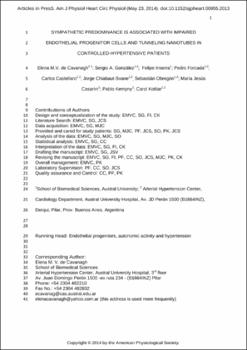| dc.description.abstract | Early endothelial progenitor cells (early EPC) and late EPC are involved in endothelial repair and can rescue damaged endothelial cells by transferring organelles through tunneling nanotubes (TNT). In rodents, EPC mobilization from the bone marrow depends on sympathetic nervous system activity. Indirect evidence suggests a relation between autonomic derangements and human EPC mobilization. We aimed at testing whether hypertension-related autonomic imbalances are associated with EPC impairment. Thirty controlled-essential hypertensive patients [systolic blood pressure/diastolic blood pressure = 130(120-137)/85(61-88) mmHg; 81.8% male] and 20 healthy normotensive subjects [114(107-119)/75(64-79) mmHg; 80% male] were studied. Mononuclear cells were cultured on fibronectin- and collagen-coated dishes for early EPC and late EPC, respectively. Low (LF)- and high (HF)-frequency components of short-term heart rate variability were analyzed during a 5-min rest, an expiration/inspiration maneuver, and a Stroop color-word test. Modulations of cardiac sympathetic and parasympathetic activities were evaluated by LF/HF (%) and HF power (ms(2)), respectively. In controlled-hypertensive patients, the numbers of early EPC, early EPC that emitted TNT, late EPC, and late EPC that emitted TNT were 41, 77, 50, and 88% lower than in normotensive subjects (P < 0.008), respectively. In controlled-hypertensive patients, late EPC number was positively associated with cardiac parasympathetic reserve during the expiration/inspiration maneuver (rho = 0.45, P = 0.031) and early EPC with brachial flow-mediated dilation (rho = 0.655; P = 0.049); also, late TNT number was inversely related to cardiac sympathetic response during the stress test (rho = -0.426, P = 0.045). EPC exposure to epinephrine or norepinephrine showed negative dose-response relationships on cell adhesion to fibronectin and collagen; both catecholamines stimulated early EPC growth, but epinephrine inhibited late EPC growth. In controlled-hypertensive patients, sympathetic overactivity/parasympathetic underactivity were negatively associated with EPC, suggesting that reducing sympathetic/increasing parasympathetic activation might favor endothelial repair. | en_US |


